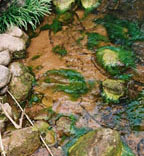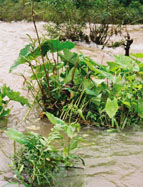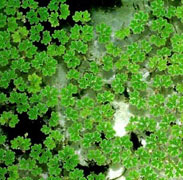Aquatic
Macrophytes--
Macrophytes (literally 'large plants') is the term applied to individual
plants that can be seen by the unaided eye. They include some species
of algae (known as macroalgae), a very few specialised mosses, liverworts
and lichens, a small number of ferns and, predominately, flowering plants.
Mosses and their relatives tend to occur in highland areas where the river
is cool and turbulent. Unlike most other macrophytes they grow in shaded
conditions, and encrust rock surfaces providing a habitat for invertebrates.
Macroalgae
 Macroalgae
are mainly filamentous forms (such as the chlorophyte Cladophora)
occurring as tufts on hard substrate, but some (e.g., Chara) are
branched with carbonate deposits strengthening them. Batrachospermum,
a filamentous red algae, occurs in shaded streams although, despite its
common name, it is gray-green. Some filamentous cyanobacteria (e.g., Nostoc,
Rivularia) can also be included under the category of macroalgae,
as their filaments clump together to form small, firm nodules (like peas)
on rocks.
Macroalgae
are mainly filamentous forms (such as the chlorophyte Cladophora)
occurring as tufts on hard substrate, but some (e.g., Chara) are
branched with carbonate deposits strengthening them. Batrachospermum,
a filamentous red algae, occurs in shaded streams although, despite its
common name, it is gray-green. Some filamentous cyanobacteria (e.g., Nostoc,
Rivularia) can also be included under the category of macroalgae,
as their filaments clump together to form small, firm nodules (like peas)
on rocks.
Flowering aquatic macrophytes
Flowering macrophytes are largely confined to low-gradient river sections
where the flow is slow. They are generally rooted in the riverbed, but
a few attach to rocks or float freely on the water surface. While tropical
latitudes support more species of aquatic flowering macrophytes than temperate
sites, their species diversity in individual sections of a river may be
quite low.  Local
conditions dictate which species can survive, but the general trend is
that the stony upper course of rivers is especially species poor, and
richness increases in a downstream direction. Seasonal fluctuations in
macrophyte abundance in river channels are a result of scouring of the
bottom sediments and washout of plants during monsoonal rains, and this
means that the amount of macrophytes tends to peak during the dry season.
Local
conditions dictate which species can survive, but the general trend is
that the stony upper course of rivers is especially species poor, and
richness increases in a downstream direction. Seasonal fluctuations in
macrophyte abundance in river channels are a result of scouring of the
bottom sediments and washout of plants during monsoonal rains, and this
means that the amount of macrophytes tends to peak during the dry season.
Floodplain sites often support the richest accumulations of aquatic macrophytes,
and the vegetation is enriched many species of semi-aquatic macrophytic
hydrophytes (i.e., 'water-loving plants': see next section). The ecological
role of all of these plants is to provide a substrate or a refuge for
many species of aquatic animals, and a surface for the growth of periphyton;
in essence, they add three-dimensional complexity to the aquatic habitat.
Flowering macrophytes photosynthesize thereby producing oxygen, which
may be limiting in backwaters or some floodplain sites, and generating
new plant tissue. Although some fishes can eat living macrophytes (see
Section 12), most of this plant material is unpalatable to herbivores
while it is alive. Energy is transferred to animals only when the dead
tissue and associated decomposers are eaten (see Section 7-'Autotrophs
and Primary Production').
Rooted aquatic macrophytes
Most macrophytes have few adaptations to living in fast current and can
root only in places where the flow is slow enough to permit accumulation
of fine sediments. They may extract nutrients from the substrate in which
they are rooted, as well as (like algae) absorbing them from the water
column. Plants rooted in the riverbed have leaves that are submerged (e.g.,
Cryptocoryne spp.: Araceae), or floating on the surface (e.g.,
water lilies: Nymphaea spp.), or emergent above the surface (e.g.,
lotus: Nelumbo nucifera), or some combination of these growth forms
(e.g., Sagittaria sagittifolia: Alismataceae). Where the water
is turbid, only plants with floating or emergent leaves can thrive. As
a broad generalization, the growth of macrophytes tends to be inhibited
in acidic, nutrient-poor waters, but there are exceptions as individual
species vary considerably in their tolerance to, or requirement for, particular
conditions of water chemistry and their need for light.
Floating aquatic macrophytes
Floating un-rooted plants can only persist in backwater areas where the
flow slackens – otherwise they are carried downstream. Because their photosynthetic
surfaces are above the water surface, these plants can grow in deep, turbid
water and places where rooting sites are lacking. Buoyancy is achieved
through very small size (in Duckweeds and the tiny floating fern Azolla
pinnata) or the possession of air-filled tissues in larger species.
Reproduction in most floating plants and certain submerged macrophytes
can occur vegetatively with new individuals developing initially as extensions
of the parent that, in some species, are known as stolons.
 |
 |
In some cases, floating plants are so numerous
that they form dense mats covering the water surface, with individuals
joined by stolons. Their buoyant leaf crowns merge above the surface whilst
the root masses dangle below into the water. Some floating plants grow
extremely quickly, especially in floodplain pools and in backwaters of
the river channels where flows are reduced or during periods of low water.
The interlocking vegetation mat blocks light penetration of the water
column and prevents the growth of other plants. In extreme cases, the
underlying water becomes deoxygenated, and floating plants turn into a
nuisance by inhibiting the passage of boats and interfering with fishing.
As flows increase and water levels rise during the wet season, floating
mats are carried by the current into the main channel where they break
up and drift downstream to colonize other parts of the river or out to
sea to die.
The most familiar example of a nuisance floating plant is Water hyacinth
(Eichhornia crassipes: Pontederiaceae), that has been spread across
the tropics far beyond its origin in South America (Barrett 1989). It
is particularly troublesome in places where rivers have been dammed, as
the standing waters in the impoundment provide ideal conditions for development
of Water hyacinth mats. Other nuisance species include Salvinia molesta
(Salviniaceae), a type of floating fern from Africa, and Nile cabbage,
Pistia stratiotes (Araceae). Nuisance plants, especially Water
hyacinth, thrive in conditions where the river receives nutrient-rich
urban or agricultural run-off from the surrounding land.
Because they are regarded as pests, there have been numerous efforts to
control nuisance floating plants throughout the tropics. The basic approaches
are mechanical removal of the plants, chemical control by herbicides,
and biological control using insects that feed on the plants. Mechanical
and chemical control have the disadvantages of being expensive, and herbicides
may have undesirable severe side effects. Biological control, while slower,
has usually proved more effective (e.g., Room, 1990).